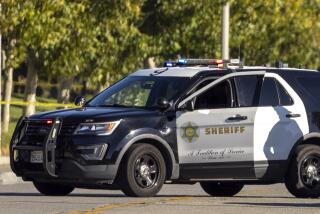ATF sought to downplay guns scandal, emails show
- Share via
Reporting from Washington — Two days after U.S. Border Patrol Agent Brian A. Terry was killed in December, the top ATF supervisors in Phoenix said in internal emails that weapons found at the scene in Arizona came from a failed agency sting operation.
But nearly two months later, when U.S. Sen. Charles E. Grassley (R-Iowa) inquired about the origin of the guns, senior officials in Washington with the Justice Department and its Bureau of Alcohol, Tobacco and Firearms were evasive.
Grassley asked whether the guns were “used” in the killing. According to agency emails obtained by the Tribune/Times Washington bureau, the Justice Department response to Grassley said that “these allegations are not true.” The response made no acknowledgement that the guns were even there.
ATF officials, speaking not for attribution because the probe is ongoing, said they saw a distinction between the guns being found at the scene and “used” in the killing. They said the FBI had determined that neither of the two AK-47 semiautomatics was the one that killed the agent.
The parsing of the response to Grassley fit a pattern of ATF and Justice Department officials seeking to minimize the depth of the problems with the sting operation run by the ATF’s Phoenix field office.
The goal of the sting operation, dubbed Fast and Furious, was to observe but not prevent a series of illegal gun purchases in the hopes that agents could follow the guns and learn about smuggling routes into Mexico. The program, which began in November 2009, largely failed. ATF lost track of many of the weapons. Along with the two guns found at the Terry shooting, nearly 200 more were found at crime scenes in Mexico.
After the death of Terry and Grassley’s inquiries, the agency sought to close ranks. In an email on Feb. 3, ATF supervisors were told “you are in no way obligated to respond to congressional contacts or requests for information.... You are not authorized to disclose non-public information about law enforcement matters outside of ATF or the Department of Justice to anyone, including congressional staff.”
In addition, in a series of emails to William J. Hoover, the ATF’s acting deputy director, bureau officials discussed what steps to take to throw Grassley and congressional investigators off the trail.
Grassley and Rep. Darrell Issa (R-Vista), chairman of the House Committee on Oversight and Government Reform, are investigating who in Washington approved the program and why it was not shut down months before ATF ultimately halted it.
Grassley started asking questions in late January, when he received tips that two of the weapons found near Terry’s body were Fast and Furious guns. He sent two letters to the ATF, saying “this raises a host of serious questions that the ATF needs to address immediately.” He added that, if they were indeed Fast and Furious guns, then “the ATF may have become careless, if not negligent, in implementing” the program.
According to the internal emails, two days after Terry’s killing on Dec. 14 the top two ATF field supervisors in Phoenix were openly discussing that Fast and Furious guns were found at the scene. George T. Gillett Jr., then the acting special agent in charge, sent his boss, William D. Newell, the agent in charge, a “narrative of incident/activity” about the death.
It said Jaime Avila bought three AK-47s a year earlier from a Phoenix-area store and two “were recovered in the area” of Terry’s killing. “In summary,” the email said, “Avila admitted to ATF agents that he straw purchased these firearms for an unidentified Hispanic male.”
After Grassley’s inquiries, Hoover received an internal email alerting him that the bureau was “receiving reports that Grassley’s staff is contacting current and former ATF field agents to inquire about the open investigation into the Brian Terry murder” and Fast and Furious. According to one email, ATF officials believed that Grassley was growing more suspicious because “ATF is not answering” his concerns.
They seemed further alarmed when they learned a mid-level ATF supervisor “called to the carpet” an employee who had spoken with Grassley’s staff. The employee “was ordered to write a memorandum disclosing everything” he told the senator’s staff. The email said Grassley’s office had expressed concern that the ATF supervisor may have violated federal laws intended to protect whistle-blowers.
As the agency continued to work on a written response to Grassley, an email to Hoover proposed a “watered-down” account of what was found at the site of the Terry killing. As an aside, the email added that Grassley was “at best imposing an unobtainable standard on ATF.”
ATF finally sent Grassley a two-page response Feb. 4, under the signature of Assistant Atty. Gen. Ronald Weich. It largely defended the Fast and Furious program and devoted one paragraph to the Terry killing: The agency could not comment about “pending criminal investigations.”
According to one email, it was sent with the approval of acting ATF Director Kenneth E. Melson. “He’s good to go with it,” it said.
Hoover praised the response. “Nice touch partner,” the No. 2 man at ATF said about a colleague’s work on the letter.
Indeed, several senior ATF and Justice Department officials dispatched emails congratulating one another. “You’re a natural leader,” one told Hoover. “The men and women are lucky you’ve stayed the course.”
Whether Grassley and his staff would be satisfied with their response, they were left to wonder. As one official put it, “Whether or not they buy in, you are the man for supporting us like that.”
More to Read
Sign up for Essential California
The most important California stories and recommendations in your inbox every morning.
You may occasionally receive promotional content from the Los Angeles Times.











